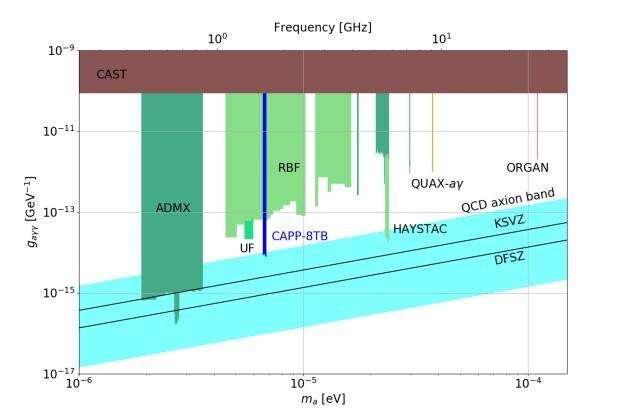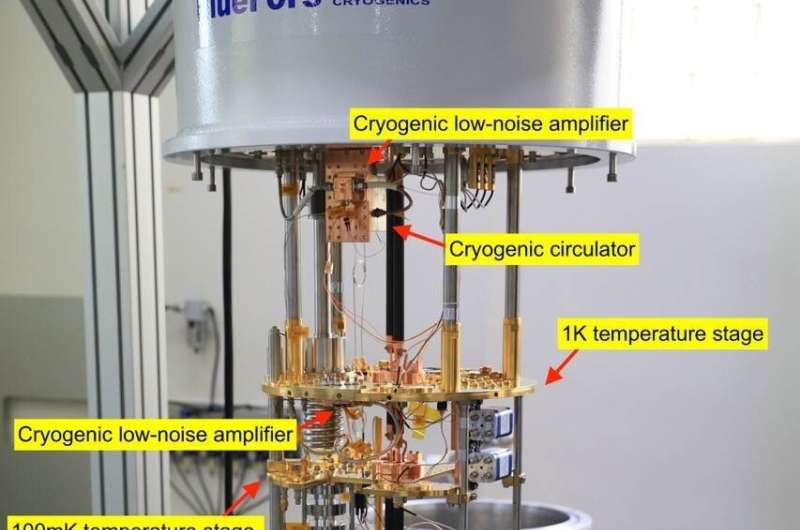Figure 1. Status of the axion search by various experiments to date. The lower horizontal axis is the axion mass, the upper horizontal axis is the microwave frequency corresponding to the mass, and the vertical axis is the coupling constant of axion-to-photon conversion. Both axes are in logarithm scales. CAPP-8TB indicates the range of mass reported in this study. CAST indicates experimental results from CERN (Switzerland) published in 2017, RBF is the result from Brookhaven National Laboratory (BNL) in a collaboration of University of Rochester, BNL, and Fermi National Accelerator Laboratory (US) published in 1989. UF is the result from University of Florida (US) published in 1990, ADMX is the range scanned at University of Washington (US) from 1998 to 2018. HAYSTAC is the result scanned at Yale University (US) from 2017 to 2018. ORGAN and QUAX-aγ are the results from University of Western Australia (Australia) and INFN (Italy) in 2017 and 2019, respectively. KSVZ and DFSZ are two models that can solve the strong CP problem. Credit: Institute for Basic Science
Researchers at the Center for Axion and Precision Physics Research (CAPP), within the Institute for Basic Science (IBS, South Korea), have reported the first results of their search of axions, elusive, ultra-lightweight particles that are considered dark matter candidates. IBS-CAPP is located at Korea Advanced Institute of Science and Technology (KAIST). Published in Physical Review Letters, the analysis combines data taken over three months with a new axion-hunting apparatus developed over the last two years.
Proving the existence of axions could solve two of the biggest mysteries in modern physics at once: why galaxies orbiting within galaxy clusters are moving far faster than expected, and why two fundamental forces of nature follow different symmetry rules. The first conundrum was raised back in the 1930s, and was confirmed in the 1970s when astronomers noticed that the observed mass of the Milky Way galaxy could not explain the strong gravitational pull experienced by the stars in the galaxies. The second enigma, known as the strong CP problem, was dubbed by Forbes magazine as "the most underrated puzzle in all of physics" in 2019.
Symmetry is an important element of particle physics and CP refers to the Charge+Parity symmetry, where the laws of physics are the same if particles are interchanged with their corresponding antiparticles (C) in their mirror images (P). In the case of the strong force, which is responsible for keeping nuclei together, CP violation is allowed theoretically, but has never been detected, even in the most sensitive experiments. On the other hand, CP symmetry is violated both theoretically and experimentally in the weak force, which underlies some types of radioactive decays. In 1977, theoretical physicists Roberto Peccei and Helen Quinn proposed the Peccei-Quinn symmetry as a theoretical solution to this problem, and two Nobel laureates in Physics, Frank Wilczek and Steven Weinberg, showed that the Peccei-Quinn symmetry results in a new particle: the axion. The particle was named after an American detergent, because it should clean the strong interactions mess.
Currently, it is estimated that 85% of matter in the universe consists of dark matter, which is imperceptible. Dark matter provides enough mass to hold the sun from leaving the Milky Way, but it is not visible under ordinary conditions. In other words, axions are expected to be present in large amount in the Universe, but to barely interact with the particles that are familiar to us.
According to the predictions and Fermi's golden rule, an axion transforms spontaneously into two detectable particles (photons) at an extremely low rate, and this conversion can be faster in an environment where one of the photons is already present. In experiments, that role is played by a strong magnetic field, which provides photons of all energy levels (virtually), speeding up the process tremendously.
To facilitate the axion-to-photon conversion, IBS researchers used their custom made CAPP-8TB haloscope. This instrument has a cylinder-shaped superconducting magnet with a clear bore of 165 mm and a central magnetic field of 8 Tesla. The signal of the axion-spawned photons is amplified in a resonant cavity. If the right frequency is chosen, the photons would resonate in the cavity and mark their presence with a little flash. The team would need to detect about 100 microwave photons per second to make a confident statement.
Figure 2. The CAPP-8TB experiment system. At the bottom, bore of the superconducting magnet (not shown in the photo) surrounds the resonant cavity, hanging on the lowest temperature stage. Various electronic components are placed at each temperature stage and further electronics are located outside the refrigerator. Credit: Institute for Basic Science
"This experiment is not a 100-meter sprint, but the first goal in a marathon run. We learned by doing, and we tested new concepts to be used at higher-level systems in the future," explains Yannis K. Semertzidis, the director of the Center and also a professor of KAIST.
In this experimental run, the team searched axions with a mass between 6.62 and 6.82 μeV, corresponding to the frequency between 1.6 and 1.65 GHz, a range that was selected by quantum chromodynamics. The researchers showed experimentally with a 90% confidence level, the most sensitive result in the mass range to date, that there is no axion dark matter or axion-like particle within that range. In this way, CAPP-8TB takes its place among other axion-hunting experiments that are looking at various possible masses. Moreover, this is the only experiment at that mass range that reaches near the sensitivity required according to the two most famous theoretical models about axions: the KSVZ model and the DFSZ model. The letters are abbreviations that refer to the scientists who proposed them.
"We proved that we can reach much better sensitivity than all other experiments in that frequency range and that we are ready to scale up our research with larger systems. We aim to be at the top of our field for the next 10 years. That's why it's so exciting," says Research Engineering Fellow Soohyung Lee, the first author of the study.
The mass range is determined by the diameter of the cavity. A bigger diameter can search a lower-mass region and vice versa. Since CAPP-8TB's resonant cavity is placed inside the clear bore of the superconducting magnet, IBS researchers designed a tunable copper cylindrical cavity as a resonator with the maximum available volume.
Beyond the cavity, the CAPP-8TB haloscope boasts a number of cutting-edge technologies, including a cryogenic dilution refrigerator reaching –273 degrees Celsius (just about 50 mK above absolute zero), a superconducting magnet with a strong magnetic field, low-noise microwave electronics and state-of-the-art amplifiers.
The plan is to look for axions tuning the haloscope at a frequency of 1 to 10 GHz, and later of 10 to 25 GHz using a more powerful magnet with large volume, implementing all their inventions. The search for axions continues nonstop.
More information: S. Lee et al. Axion Dark Matter Search around 6.7 μeV, Physical Review Letters (2020). DOI: 10.1103/PhysRevLett.124.101802
Journal information: Physical Review Letters
Provided by Institute for Basic Science

























